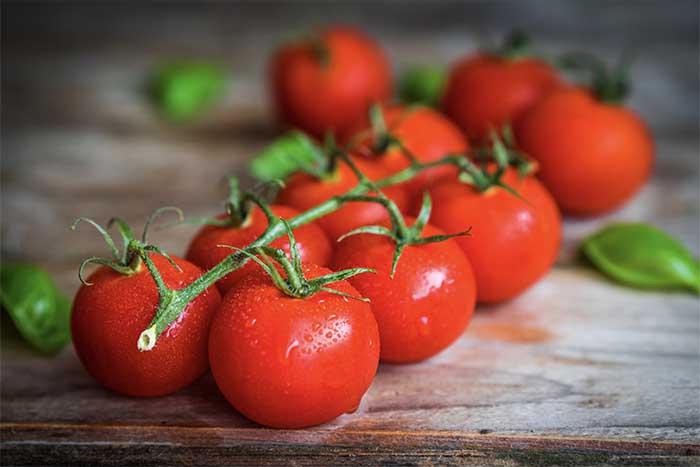
Tomatoes provide rich, earthy flavors to many types of wine. They are best known for their role in making Sangiovese-based red wines. There are different types of tomato wine. For example, there are wines fermented with tomato skins and pulp, wines fermented with tomato seeds, and wines fermented with tomato pulp alone.
Tomato wine is made from any tomato, including cherry tomatoes, beefsteak tomatoes, Roma tomatoes, or any other type of tomato on the market. The best tomatoes for making tomatoes have a very high water content, which is essential for producing wine. On the other hand, the best tomatoes for eating have lower water content and are juicier.
Red tomatoes can have a piquant bitterness when used in high concentrations in wine. However, there are other types of tomato that provide a sweeter, fruitier addition to your batches of vino.
Green tomatoes have herbal and grassy notes that work well with lighter-style whites and rosé wines. Their balanced acidity means you can use them almost anywhere you typically use green grapes.
Yellow tomatoes bring a golden hue to white wines, and berries like yellow cherries provide dark sweetness for darker reds—from merlots to barbers. Read on for more information about this lesser-known fruit used in fermented beverages and discover 5 tips for making unique tomato wine!
Know Your Tomatoes
According to Backyard Gardeners Network, it’s best if you can grow tomatoes on your own, homegrown tomatoes taste much better than the ones bought from stores, and is best for making wine.
Another step in making tomato wine is choosing the right kind of tomato to use. Unfortunately, most of the tomatoes you’ll find at your local grocer will be too tart and acidic to use in winemaking. Instead, you’ll need to source some specialty tomatoes bred for their sweetness and lower acidity levels.
For red wines, you’ll want to look for varieties like “Early Blaze,” “Cappelli,” “Mortgage Lifter,” and “Orange Blossom.” These types of tomatoes have a high sugar content and low acidity, making them perfect for winemaking.
For whites and rosés, you’ll want to use green tomatoes. They have a distinct flavor with hints of grass, citrus, and green pepper.
Don’t Forget the Acid.
Tomatoes are rich in pectin, which helps to thicken wine. For those making darker reds, this is great. But when making lighter styles, you’ll likely want to blend in some grapes to help with the fining process.
When you add grapes, you’ll want to make sure the tomatoes balance out the acidity. If not, your wine will be overly tart and need to be aged for years before it’s even drinkable. You can help balance the acidity by adding some tartaric acid. For added citrus notes, you can use other fruit such as cranberries, orange peels, or lemon peels.
Use Ripe Tomatoes
As with any fruit used in winemaking, you want to ensure it’s ripe and sun-ripened. Green tomatoes are toxic and can make your wine poisonous. If you’re unsure of the tomatoes’ ripeness, add them to a paper bag to speed up the ripening process.
Ripe tomatoes have higher sugar levels and will provide a more prosperous, sweeter flavor than unripe ones. They’ll also have much lower acidity, making them easier to work with when blending other fruits and vinegar.
Blended ripe tomatoes provide a dark, rich flavor that is used to make many styles of red wine. They are often blended with herbs like oregano and basil to add a unique twist to the flavors.
Incorporate Herbs and Spices
When creating your signature wine, you don’t need to stick to grapes and tomatoes. Many herbs and spices are perfect for your red or white wine. Some herbs that work well include oregano, thyme, basil, and sage.
You can also add seeds like anise, fennel, and coriander. These additions will not only provide a unique flavor but will also give your wine medicinal qualities. Some spices that blend well with wine include cinnamon, clove, and nutmeg.
Add Other Natural Flavors
Tomatoes are delicious on their own. But they also blend well with many other natural flavors. Blending tomato wine with other fruits and juices can give your wine a rich, full flavor. Some common additions include blackberries, blueberries, strawberries, oranges, and peaches. You can also use red wine and balsamic vinegar to add even more flavor.
Making tomato wine may seem odd initially, but it’s a great way to spice up your fermented beverage repertoire. It can also be a great way to use any excess tomatoes in your garden. You’ll want to use red tomatoes to make red wine and green tomatoes to make white or rosé wine. You can also use yellow or ripe red tomatoes to create a dark, rich color in your red wines. Blend in ripe tomatoes, herbs, and spices to create a signature blend and make tomato wine one of the unique varieties you’ve ever tried! Now that you know more about this unique fermented beverage, are you ready to try making a tomato wine? Follow these tips, and you’ll be well on creating your signature tomato wine. Enjoy!